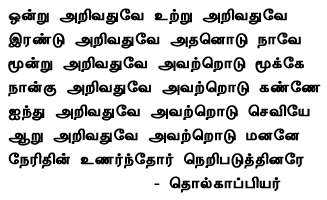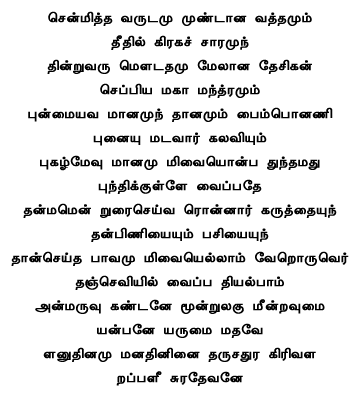The classification of the senses and the specifying of beings that fall under this classification is found in the oldest surviving work on Tamil Grammar - The Thollkaappiyam. Thollkaappiyam is a combination of the words Thonmai (very old, ancient) + Kaappiyam (Literature). The name Thollkaappiyam stood because the actual time when this piece of literature was written is not known, some say it is over 2000 years old and some say it was written between 1st CE and 10th CE. Also some say that the name of the author, Thollkaappiyar, is a generic name derived from the name of the work, as the exact details of the person who wrote it is not known. And some strongly believe that Thollkaappiyar was a disciple of Agathiar, the first and foremost of Siddhars and Thollkaappiyar wrote his work based on Agathiar's work Agathiam. However, Thollkaappiyam is a masterpiece and the oldest surviving work on literature on any language. Well, lets get back to the classification.
Thollkaappiyar, classifies the beings based on the senses they use predominantly, in the section called Marabiyal (Marabu - generally accepted practices since old days, culture, tradition. Iyal - Research work, Science). The poems in each called Suthirams (Formulae) describe about various aspects of grammar, habitat, etc. The song that we intend to read goes like this

"Ondru Arivadhuvae Uttru Arivadhuvae
Irandu Arivadhuvae Adhanodu Naavae
Mondru Arivadhuvae Avattrodu Mookae
Naangu Arivadhuvae Avattrodu Kannae
Aindhu Arivadhuvae Avattrodu Seviyae
Aaru Arivadhuvae Avattrodu Mananae
Naeridhin Unarrndhor Neripaduthinarae"
meaning, beings with one sense are those that have the sense of TOUCH. Beings with two senses are those that have the sense of TASTE along with the above. Beings with three senses, have sense of SMELL in addition. Beings with four senses, have sense of SIGHT, along with the above. Beings with five senses, have sense of HEARING, in addition. The beings with six senses, have a MIND, along with the above. The people who have realised this truth have classified and organised it appropriately
Ondru, Irandu, Moondru, Naangu, Aindhu, Aaru - 1, 2, 3, 4, 5, 6 respectively
Arivadhu - Know, feel, realise, sense
Uttru - Touch, come into contact
Athanodu - Along with some other thing (usually when the number of objects is two)
Avattrodu - Along with some other things (usually when the number of objects is more than two)
Naavu - Tongue, in this context, taste
Mooku - Nose (for sense Smell)
Kann - Eye (Sight)
Sevi - Ear (Hearing)
Manam - Mind
Naer Idhu - This truth (the above mentioned classification)
Unarrndhor - People who realised this truth
Neripaduthinarae - Classified and organised the truth
Thollkaappiyar, does not stop with this classification alone, he also gives examples of beings in each of these classifications. The poems go like below

"Pullum Maranum Ore Arivinavae
Piravum Ulavae Akkilai Pirappae"
meaning Grass (Pull) and Trees (Maram) have single sense, that is the sense of touch. Similar beings also form part of this branch.

"Nandhum Muralum Eer Arivinavae
Piravum Ulavae Akkilai Pirappae"
meaning Snails (Nandhu) and Oysters or Molluscs (Mural) have two senses,the sense of touch and taste. Similar beings also form part of this branch.

"Sidhalum Erumbum Moo Arivinavae
Piravum Ulavae Akkilai Pirappae"
meaning Termites (Sidhal) and Ants (Erumbu) have three senses, the sense of touch, taste and smell. Similar beings also form part of this branch.

"Nandum Thumbiyum Naangu Arivinavae
Piravum Ulavae Akkilai Pirappae"
meaning Crabs or Crustaceans (Nandu) and Dragonfly or Beetles (Thumbi) have four senses, the sense of touch, taste, smell and vision. Similar beings also form part of this branch.

"Maavum Maakkalum Aindhu Arivinavae
Piravum Ulavae Akkilai Pirappae"
meaning Horses, Elephants, Pigs (Maa) and Other similar animals and birds (Maakkal) have five senses, the sense of touch, taste, smell, vision and hearing. Similar beings also form part of this branch.

"Makkalthamae Aaru Arivu Uyirae
Piravum Ulavae Akkilai Pirappae"
meaning Only humans have six senses, the sense of touch, taste, smell, vision, hearing and mind. Similar beings also form part of this branch.
Truly amazing classification, though these classifications are based on the what the beings predominantly use for their survival. For eg though the ants have eyes, they predominantly use the three senses mentioned above. This proves that Thollkaappiyar is not only an expert in literature and grammar, but also a multi-faceted human having expertise in animal and plant life and other sciences too. It is no surprise that the Tamil Culture having an ancient history that spans over thousands of years to have made this classification and much more. His work in our hands is what we need to be proud of and we can proclaim it to the world for generations to come that our culture, tradition and civilisation has a long standing history that only a very few cultures have in this world. The pdf version of the Thollkaappiyam can be found here.
More to come, until then...



































